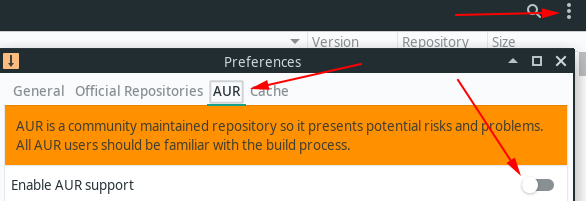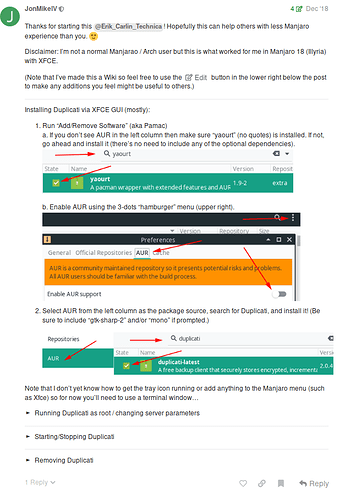Well, newer here but I feel I’ve got some things to talk about regarding installing and configuring Duplicati on Manjaro Linux. Pro tip - arch repo is a powerful tool, Manjaro certainly is a good blend between UI/user experience and accessing these packages.
None the less, here’s a week with linux and figuring out this duplicati instance.
Problem: Installed Duplicati, navigated to local host and tried every stupid command online to run as “root”, no dice. Spent a week figuring out how this could be done.
Solution:
Installing Duplicati on Manjaro is more difficult than the deb file for example online. However, accept the defaults and run the duplicati2-beta package, you can find that here or via Octopi and Yaourt installed.
https://aur.archlinux.org/packages/duplicati2-beta/
Installing it was easy, getting the service to be running was automatic. Problem was with the inability for me to save or backup /home/tech for example, it was locked and I didn’t have permission to read these directories, rather useless.
I read online how to start and stop the service and to even go the length of making it start when the computer boots, all of that. Still, every single time that you went and tried to configure the backup I was in the same position.
Finally, I came across a guide that indicated that duplicati is staring as the user too quick and despite me setting it as sudo and running it as root, it was useless as it always defaulted.
Solution:
Modify the file /usr/lib/systemd/system/duplicati.service so it DOESN’T contain a username or password. By default the username and password are duplicati and duplicati. Removing those two entries and saving the file, stopping the service and starting it again, allowed me to navigate to /home/tech and save the data. To be honest I don’t recall if there was just a username entry or both but remove both if you see two, user and pass.
[Unit]
Description=Duplicati Backup software
[Service]
ExecStart=/usr/bin/mono /usr/lib/duplicati/Duplicati.Server.exe
Restart=on-failure
RestartSec=30
[Install]
WantedBy=multi-user.target
Hopefully this helps someone out.







